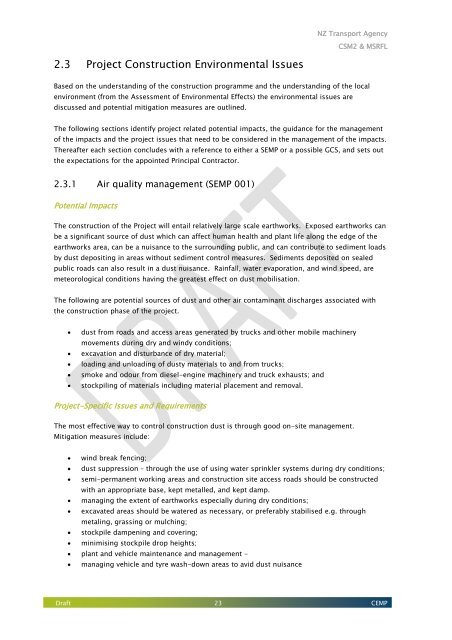CEMP - NZ Transport Agency
CEMP - NZ Transport Agency
CEMP - NZ Transport Agency
You also want an ePaper? Increase the reach of your titles
YUMPU automatically turns print PDFs into web optimized ePapers that Google loves.
<strong>NZ</strong> <strong>Transport</strong> <strong>Agency</strong><br />
CSM2 & MSRFL<br />
2.3 Project Construction Environmental Issues<br />
Based on the understanding of the construction programme and the understanding of the local<br />
environment (from the Assessment of Environmental Effects) the environmental issues are<br />
discussed and potential mitigation measures are outlined.<br />
The following sections identify project related potential impacts, the guidance for the management<br />
of the impacts and the project issues that need to be considered in the management of the impacts.<br />
Thereafter each section concludes with a reference to either a SEMP or a possible GCS, and sets out<br />
the expectations for the appointed Principal Contractor.<br />
2.3.1 Air quality management (SEMP 001)<br />
Potential Impacts<br />
The construction of the Project will entail relatively large scale earthworks. Exposed earthworks can<br />
be a significant source of dust which can affect human health and plant life along the edge of the<br />
earthworks area, can be a nuisance to the surrounding public, and can contribute to sediment loads<br />
by dust depositing in areas without sediment control measures. Sediments deposited on sealed<br />
public roads can also result in a dust nuisance. Rainfall, water evaporation, and wind speed, are<br />
meteorological conditions having the greatest effect on dust mobilisation.<br />
The following are potential sources of dust and other air contaminant discharges associated with<br />
the construction phase of the project.<br />
• dust from roads and access areas generated by trucks and other mobile machinery<br />
movements during dry and windy conditions;<br />
• excavation and disturbance of dry material;<br />
• loading and unloading of dusty materials to and from trucks;<br />
• smoke and odour from diesel-engine machinery and truck exhausts; and<br />
• stockpiling of materials including material placement and removal.<br />
Project-Specific Issues and Requirements<br />
The most effective way to control construction dust is through good on-site management.<br />
Mitigation measures include:<br />
• wind break fencing;<br />
• dust suppression – through the use of using water sprinkler systems during dry conditions;<br />
• semi-permanent working areas and construction site access roads should be constructed<br />
with an appropriate base, kept metalled, and kept damp.<br />
• managing the extent of earthworks especially during dry conditions;<br />
• excavated areas should be watered as necessary, or preferably stabilised e.g. through<br />
metaling, grassing or mulching;<br />
• stockpile dampening and covering;<br />
• minimising stockpile drop heights;<br />
• plant and vehicle maintenance and management -<br />
• managing vehicle and tyre wash-down areas to avid dust nuisance<br />
Draft 23 <strong>CEMP</strong>
















